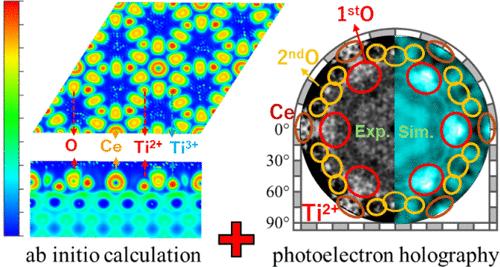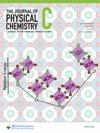Schematic Structural Analysis of Honeycomb Structure Ultrathin Ce–Ti–O Films on Pt(111) Using Photoelectron Holography and Ab Initio Calculation
IF 3.3
3区 化学
Q2 CHEMISTRY, PHYSICAL
引用次数: 0
Abstract
(√3 × √3)R30 honeycomb superstructure ultrathin Ce–Ti–O film was prepared and confirmed using scanning tunneling microscopy (STM) and low-energy electron diffraction. The structural model of (√3 × √3)R30 honeycomb superstructure ultrathin film is determined using ab initio calculation and photoelectron holography. In the density functional theory (DFT) calculations, the (√3 × √3)R30 honeycomb superstructural model was calculated in two different conditions. The photoelectron holograms of Ti2+ and Ti3+ were separated from Ti 2p photoelectron spectra of (√3 × √3)R30 honeycomb superstructure, using a display-type retarding field analyzer. From the different forward-focusing peaks on the photoelectron holograms of Ti2+ and Ti3+, the vertical height between Ti divalent atoms and O atoms is higher than that between Ti trivalent atoms and O atoms. Also, the distance and direction of O and Ce atoms above Ti could be found. As a result, the simulated photoelectron holograms and the simulated STM image of the calculated Ce–Ti–O honeycomb superstructural model agree with the experimental photoelectron holograms and the experimental STM images.

利用光电子全息技术和 Ab Initio 计算分析铂(111)上蜂巢结构超薄 Ce-Ti-O 薄膜的结构示意图
(利用扫描隧道显微镜(STM)和低能电子衍射法制备并确认了(√3 × √3)R30 蜂窝超结构超薄 Ce-Ti-O 薄膜。利用 ab initio 计算和光电子全息法确定了 (√3 × √3)R30 蜂窝超结构超薄薄膜的结构模型。在密度泛函理论(DFT)计算中,在两种不同条件下计算了 (√3 × √3)R30 蜂窝超结构模型。利用显示型阻滞场分析仪从 (√3 × √3)R30 蜂窝上层结构的 Ti 2p 光电光谱中分离出 Ti2+ 和 Ti3+ 的光电子全息图。从 Ti2+ 和 Ti3+ 光电子全息图上不同的正向聚焦峰来看,Ti 二价原子与 O 原子间的垂直高度高于 Ti 三价原子与 O 原子间的垂直高度。此外,还可以发现 O 原子和 Ce 原子在 Ti 上方的距离和方向。因此,计算出的 Ce-Ti-O 蜂窝超结构模型的模拟光电子全息图和模拟 STM 图像与实验光电子全息图和实验 STM 图像一致。
本文章由计算机程序翻译,如有差异,请以英文原文为准。
求助全文
约1分钟内获得全文
求助全文
来源期刊

The Journal of Physical Chemistry C
化学-材料科学:综合
CiteScore
6.50
自引率
8.10%
发文量
2047
审稿时长
1.8 months
期刊介绍:
The Journal of Physical Chemistry A/B/C is devoted to reporting new and original experimental and theoretical basic research of interest to physical chemists, biophysical chemists, and chemical physicists.
 求助内容:
求助内容: 应助结果提醒方式:
应助结果提醒方式:


